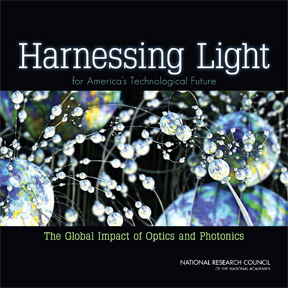Harnessing Light Report: Findings and Interpretations
Harnessing Light Report: Findings and Interpretations
Lia Moore
The National Research Council (NRC) of the U.S. National Academies of Science released a much-awaited draft report on optics in August to much fanfare. OSA issued a statement supporting the work, as did its sibling societies. (You can download a free copy of the report here and see OSA’s roundtable discussion of it here.)
Now, what does it mean?
First, about the title. The official title of the report is “Optics and Photonics: Essential Technologies for Our Nation.” The report was issued through the Harnessing Light Committee of the NRC, reflecting the name of an earlier report on the topic from 1998, called “Harnessing Light: Optical Science and Engineering for the 21st Century.” Consequently, some are calling it “Harnessing Light II,” as in: the sequel. (In fact, it’s the third of a trilogy. There was a 1988 report from the NRC, “Photonics: Maintaining Competitiveness in the Information Era.” That makes the new report “Harnessing Light III.”)
Second, to be precise, the report is done but is officially called a draft until some editorial details are ironed out. It is expected to be ready in October.
Most importantly, what does the report say? Optics is a diverse set of technologies, enabling a broad array of applications. The report reflects this, with many chapters each dedicated to major application areas: communications, biomedicine, national security, manufacturing, displays, and so on. In each case, the report identifies major findings and recommendations that would be useful to government and industry stakeholders.
I found particularly notable an entire chapter near the front on the impact of optics in the economy. The report itself notes that good data is lacking, and calls for better tracking, but it lays out the case for optics as a key enabler for the economy. This sets the tone of the report.
 It parallels a 2011 report prepared for the European Commission, called “The Leverage Effect of Photonics Technologies: the European Perspective.” That report was entirely dedicated to the economic case, and claimed that the European photonics market is 21% of the world market, it employs nearly 300,000 people, and there are 5,000 European companies active in the field. The NRC and EC reports complement each other in this way, making the case for optics in different ways.
It parallels a 2011 report prepared for the European Commission, called “The Leverage Effect of Photonics Technologies: the European Perspective.” That report was entirely dedicated to the economic case, and claimed that the European photonics market is 21% of the world market, it employs nearly 300,000 people, and there are 5,000 European companies active in the field. The NRC and EC reports complement each other in this way, making the case for optics in different ways.
What happens next? OIDA plays a role. In the current tight budget environment, and given the more obscure standing of optics (compared to, for example, the auto industry), the committee didn’t expect the report to be an end in itself, but an enabler, like the industry it describes. The authors use phrases like “it needs to be interpreted,” “it’s a starting point for dialogue,” and “it politely makes our voice heard.” They expect government and industry stakeholders to use it to move the ball downfield, so to speak.
Most recommendations in the report fall to government agencies, with nudging from industry and its stakeholders, including professional societies. References to public/private partnerships are woven throughout the work. In fact, OIDA is active in several topics addressed in the report, as well as others not addressed there. Most notable are efforts in communications: photonic integration and data centers. OIDA plans to increase efforts in these and other topics, and to leverage the report to address pressing issues in optoelectronics.
A few words about expectations. Many have noted that the 1998 U.S. report was used by other countries, particularly Germany, to promote its own program in optics. This is somehow taken to suggest that the U.S. community dropped the ball when that report came out, while a competing government stepped in and used it to its advantage.
To me, that is the wrong way to look at it. The new report quite rightly addresses the issues facing its U.S. community, not elsewhere. Of course, leading countries and regions in optics look to each other for validation and a call for action. But each country and region is different: the U.S. shies away from picking industries to promote in the way that, say, Germany, Taiwan, or China do. Advocating for photonics, and measuring success, will look different in the U.S. than it will elsewhere.
The new report provides an opportunity for OIDA and the optics community. The committee aimed to be comprehensive, yet practical. Having worked myself on reports of this kind for the U.S. Congress, back in the 1990s, I can vouch that it’s a difficult task, and I think the committee did as well as anyone could have done with their assignment. Now it’s time for the community to take the report and continue to “make our voice heard.”
Written by Tom Hausken. Tom Hausken is Senior Engineering & Applications Advisor at OSA, where he supports several activities within OIDA.
